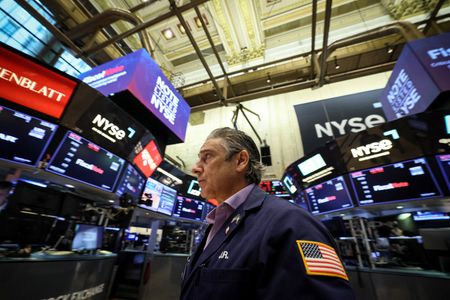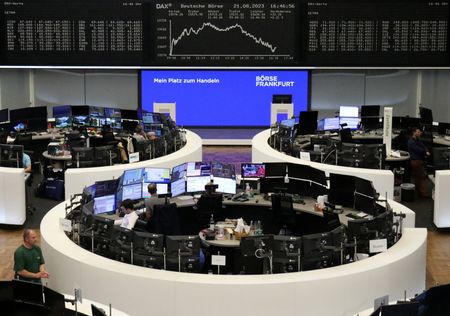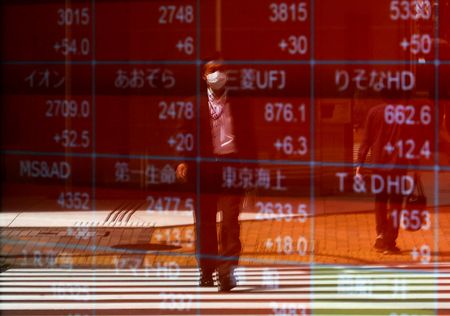By Karin Strohecker and Koh Gui Qing
NEW YORK/LONDON (Reuters) -A comeback rally in global stocks fizzled on Tuesday as benchmark Treasury yields hit a near 16-year high on concerns that interest rates could stay higher for longer, which kept the safe-haven dollar firm near 10-week highs.
The MSCI All Country stock index gave up earlier gains to finish flat, pulling further from Friday’s 2-1/2 month trough.
The S&P 500 lost 0.28%, the Dow Jones Industrial Average fell 0.51%, and the Nasdaq Composite Index was little changed.
Markets are awaiting more hints on the outlook for interest rates from policy makers when Federal Reserve officials and policy makers from the European Central Bank, the Bank of England and the Bank of Japan head to Jackson Hole, Wyoming, for their annual central bank conference later this week.
Powell “is unlikely to give direction on September, but he is likely to hint at elevated rates for longer to ensure that inflation has come down,” analysts at TD Securities said, referring to the Fed’s next policy meeting in September.
Pan-European stocks jumped 0.7%, helped by a rally in tech shares.
But it was U.S. Treasuries that hogged the limelight once again, with benchmark 10-year yields climbing to 4.366% – their highest level since 2007 and up almost 40 bps month-to-date – before losing some ground to 4.318%. [US/]
“There’s a more cautiously optimistic mood across financial markets,” said Fiona Cincotta, senior markets analyst at City Index in London.
However, she added the outlook for equities in particular remained challenging.
“We had an optimistic July and now there’s a realisation that what the Fed has been saying about higher rates for longer will ring true,” she added, referring to the U.S. central bank.
The surge in yields – which move inversely to prices – comes in the wake of surprisingly upbeat U.S. economic news that has prompted investors to trim expectations for the Federal Reserve to ease policy next year.
Those fears of higher-for-longer interest rates and worries about China’s faltering economy have recently sapped investor appetite for stocks before the Tuesday rebound.
Treasury futures now imply 100 basis points (bps) of rate cuts by the Fed by end-2024, compared to 130 bps a couple of weeks ago.
At the same time, however, inflation expectations have hardly budged – meaning “real” yields, which discount inflation expectations, have surged – a development likely to prompt investors to re-evaluate taking risks.
“The bearish set-up … prevails, and with the 20-year Treasury sale and the Jackson Hole symposium looming large later this week, the appetite to take the other side is small,” said Padhraic Garvey, regional head of research, Americas at ING.
The near 300 bps added to 10-year U.S. real yields since September 2021 is the most acute tightening of real rates in 25 years, said Vishnu Varathan, head of economics at Mizuho Bank in Singapore. The 10-year real rate breached 2% late last week.
In Europe, benchmark bond yields in Germany, France and Italy eased after Monday’s sharp climb.
Japan’s 10-year government bond yield meanwhile hit a more than nine-year high at 0.665%, crossing a level that had prompted the Bank of Japan to intervene in the market earlier this month.
NVIDIA BOOST
In European stocks, the gains were driven by a 2% jump in the tech sector on optimism surrounding the world’s most valuable chipmaker, Nvidia, ahead of its quarterly results on Wednesday. [.EU]
Tech momentum had also lifted Asian bourses, with the Hang Seng snapping a seven-day losing streak to end 1% up.
Focus was also on U.S. banking stocks, after S&P Global late on Monday cut credit ratings and revised its outlook for multiple lenders, following a similar move by Moody’s. Funding risks and weaker profitability will likely test the sector’s credit strength, they said.
The yield moves have also heaped pressure on some lower yielding currencies with markets on watch for interventions.
The dollar index – which measures the currency against six developed-market counterparts – edged up to 103.60, a hair’s breadth from Friday’s 10-week highs at 103.68. The euro fell 0.45% to $1.08460.
China’s yuan edged back down to around 7.30 per dollar, having shown signs of stabilisation after state banks had earlier used the offshore forwards market to defend it.
The yen was also on intervention watch and caught a small boost from a meeting between Bank of Japan chief Kazuo Ueda and the prime minister. It was last about 0.24% higher at 145.855 per dollar.
(Reporting by Karin Strohecker; additional reporting by Elizabeth Howcroft, Dhara Ranasinghe and Tom Westbrook, Editing by Chizu Nomiyama, William Maclean and Cynthia Osterman)









